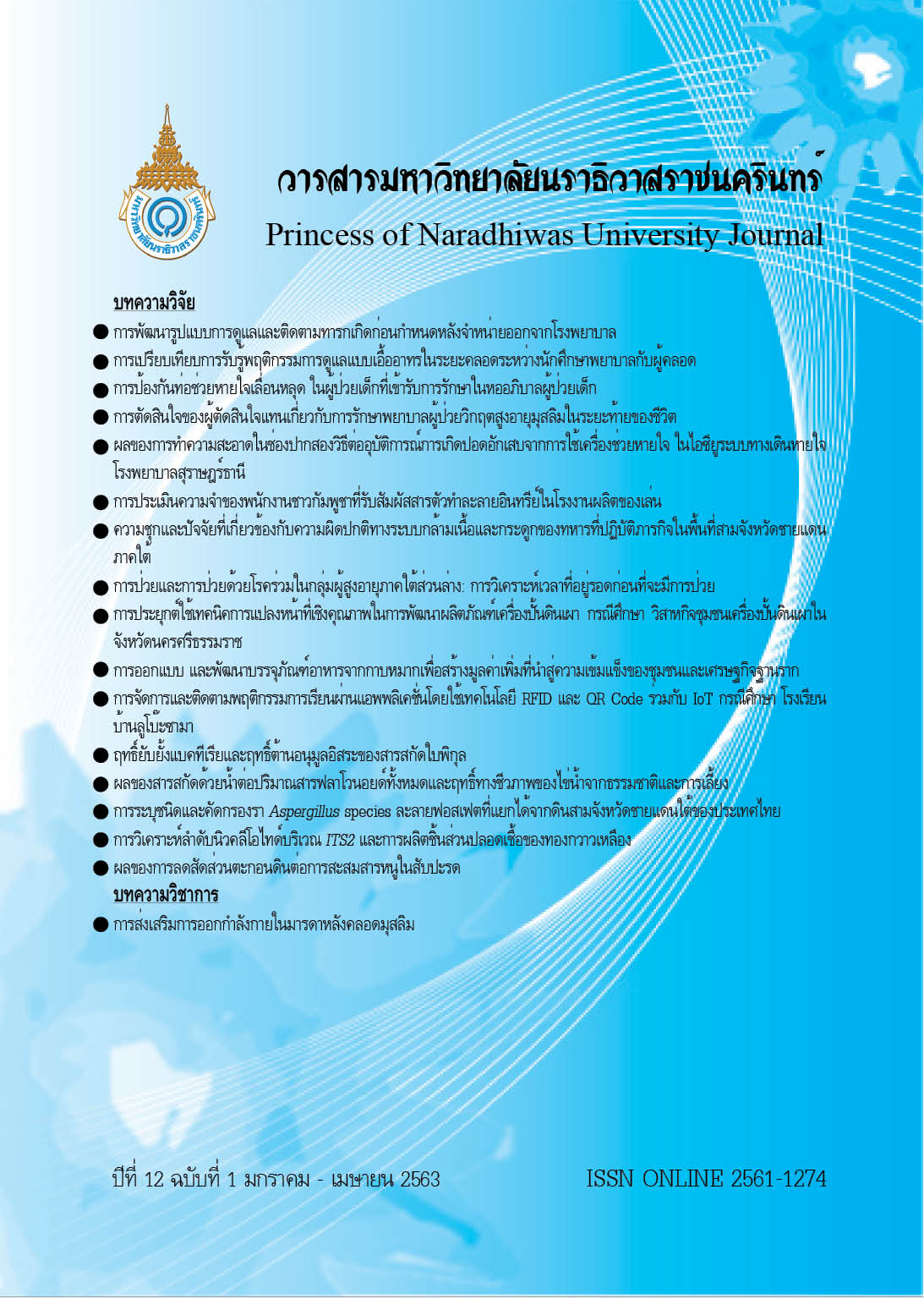Flavonoid Effects of Water Extraction on Total Flavonoid Content and Biological Activities between Natural and Cultured Wolffia globosa (Roxb.) Hartog & Plas
Keywords:
Water Meal, Flavonoids, Antioxidant Activities, Alpha GlucosidaseAbstract
The aim of this study was to compare the total flavonoid content and biological activities between natural and cultured Wolffia globosa. Natural W. globosa was collected from Khao Chai Son district,Phatthalung province (8o9’41”N, 99o43’31”E). Cultured W. globosa was culturedin a laboratory by chicken manureas.Total flavonoid content (TFC) was analyzed by aluminum chloride colorimetric assay method. Additionally, biologicalactivitiesweremeasuredbyDPPH,ABTSradicalscavengingassay,andalphaglucosidase inhibition, determined from the extracted with different conditions, it is to say at 4 ºC/24 h, 24 ºC/12 h, 50 ºC/6 h, 75 ºC/3 h and 100 ºC/1.5 h. The results found that the TFC and thebiological activities weresignificantly different between extraction method (p<0.05). The highest of TFC found was in 100 ºC/1.5 h (27.249±0.10 mg QE/g extract). The highest activity of scavenging DPPH and ABTS radical were found in W. globosa from natural (75 ºC/3 h method) with IC 50= 0.017±0.00 and 0.016±0.00 mg/ml, respectively. The highest inhibition of maltase and sucrase activities was found in 100 ºC/1.5 h and 4 ºC/24 h method of W. globosa from natural with IC50= 8.346±0.03 and 1.723±0.02 mg/ml, respectively. Inaddition, according to Peason’s correlation coefficient between all extract with IC50 of all biological activities, TFC were contribution major in its alpha glucosidase inhibition. This results obtained in this study clearly indicate that W. globosa has a significant potential to be used as natural antioxidants and, consequently, to be developed as health product.
References
Borges de Melo, E., Da Silveira Gomes, A. & Carvalho, I. (2006). α-and β-Glucosidase inhibitor: chemical structure and biological activity. Tetraedron, 62(44) , 10277-10302
Buddhakala, N., Talubmook, C., Posri, S. & Buatone, S. (2015). Effects of Ginger Extract in the Treatment of Diabetic Rats. RMUTP Research Journal Special Issue The 5th Rajamangala University of Technology National Conference, 302-311.
Chang, C., Yang, M., Wen, H. & Chern, J. (2002). Estimation of total flavonoid content in propolis by two complementary colorimetric methods. Journal of Food and Drug Analysis, 10, 178-182.
Damsud, T., Grace, M.H., Adisakwattana, S. & Phuwapraisirisan, P. (2014). Orthosiphol A from the aerial parts of Orthosiphonaristatus is putatively responsible for hypoglycemic effect via alpha-glucosidase inhibition. Natural Product Communication, 9, 639-641.
Damsud, T. & Kaewpiboon, C. (2016). In Vitro α-Glucosidase Inhibitory Activities of the Watercress (Nasturtium officinale R. Br.) Extracts. Phranakhon Rajabhat Research Journal (Science andTechnology), 11(2) , 65-74.
Damsud, T., Chanwun, T., Srimek, N. & Songsang, S. (2017). Antioxidant and α-Glucosidase Inhibitory Activities of Young Jackfruit (Artocarpusheterophyllus) Extract. KKU Science Journal, 45(3), 543-550.
Kamtchouing, P., Kahpui, S.M., Dzeufiet, P.D., Tédong, L., Asongalem, E.A. & Dimo, T. (2006). Anti-diabetic activity of methanol/methylene chloride stem bark extracts of Terminaliasuperba and Canariumschweinfurthii on streptozotocin-induced diabetic rats. Journal of Ethnopharmacology,104(3), 306-309.
Kratchanova, M., Denev, P., Ciz, M., Lojek, A. & Mihailov, A. (2010). Evaluation of antioxidant activity of medicinal plants containing polyphenol compounds. Comparison of two extraction systems. ActaBiochimicaPolonica, 57(2), 229-234.
Lou, S.N., Hsu, Y.S. & Ho, C.T. (2014). Flavonoid compositions and antioxidant activity of calamondin extracts prepared using different solvents. Journal of Food and Drug Analysis, 22, 290-295.
Meechai, P. (2010). Antioxidant activities and minerals contents of local edible aquatic plants in the northeastern of Thailand. Master’s Thesis, Department of Chemistry, Faculty of Science, Mahasarakham University. (in thai)
Niyanuch, U. (2010). The Postharvest Changes of Composition and Antioxidant Activity of Wolffiaarrhiza (Linn) Wimm. Master’s Thesis, Department of Food Technology, Faculty of Technology, KhonKaen University (in Thai) .
Nutrition Division (2001). Nutritive Values of Thai Foods. Nutrition Division, Department of Health. Ministry of Public Health (in Thai)
Panwanitdumrong, K. (2009). Studies on Factors Effecting Growth of Wolffia (Wolffiaarrhiza (L.) Wimm.) and Methodology for Mass Production Culture. Master’s Thesis, Department of Fishery Management, Faculty of Fisheries, Kasetsart University (in Thai)
Praychoen, P., Praychoen, P. & Phongtongpasuk, S. (2013). Effect of thermal treatment on phytochemical content and antioxidant activity of GacJuice. Burapha Science Journal, 18, 90-96.
Rao, P., Prabhu, P.P. & Pandey, S. (2010). Anti-diabetic activity of methanol/methylene chloride extract of Terminaliasuperba leaves on streptozotocin induced diabetes in rat. International Journal of PharmTech Research, 2(4) , 2415-2419.
Re, R., Pellegrini, N., Proteggente, A., Pannala, A., Yang, M. & Rice-Evans, C. (1999). Antioxidant activity applying an improved ABTS radical cationdecolorization assay. Free Radical Biology andMedicine, 26, 1231–1237.
Raksakaew, K., Penpapai, P. & Chankaew, W. (2018). Antioxidant activity of aqueous extracts from water meal (Wolffiaglobosa (Roxburgh) Den Hartog& Van der Plas) . In Proceedings of the 2nd Endemic Botanical Conference of Thailand (pp. PC06:1-7). Chiang Rai: Mae FahLuang University (in Thai)
Ruekaewma, N., Piyatiratitivorakul, S. & Powtongsook, S. (2015). Culture system for Wolffiaglobosa L. (Lemnaceae) for hygiene human food. Songklanakarin Journal of Science and Technology, 37, 575-580.
Saengthongpinit, W., Sricharoen, B. & Krangpreecha, M. (2017). Effect of Blanchingin Sodium Chloride Solution on Phenolic Content and Antioxidant Activity of Water Meal (Wolffiaglobosa) . The 55th Kasetsart University Annual Conference (pp. 671-677). Bangkok: Kasetsart University (in Thai) .
Shimada, K., Fujikawa, K., Yahara, K. & Nakamura, T. (1992). Antioxidative properties of xanthome on the auto oxidation of soybean in cylcodextrin emulsion. Journal of Agricultural and Food Chemistry,40, 945-948.
Thanakosai, W. & Phuwapraisirisan, P. (2013). First indentification of alpha-glucosidase inhibitors from okra (Abelmoschusesculentus) seeds. Natural product communications, 8, 1085-1088.
Türkoğlu, S. & Parlak, A.E. (2014). Determination of total phenolic and total flavonoid contents and antioxidant capacities of an aquatic plant (Ricciafluitans). Ege Journal of Fisheries and Aquatic Sciences, 31, 35-40.
Yin, Z., Zhanga, W., Fenga, F., Zhanga, Y. & Kanga, W. (2014). α-Glucocidase inhibitors isolated from medicinal plants. Food Science and Human Wellness, 3, 136-174.
Zakaria, N.A., Ibrahim, D., Sulaiman, S.F. & Supardy, N.A. (2011). Assessment of antioxidant activity, total phenolic content and invitro toxicity of Malaysian red seaweed, Acanthophoraspicifera. Journal of Chemical and Pharmaceutical Research, 3, 182-191.




